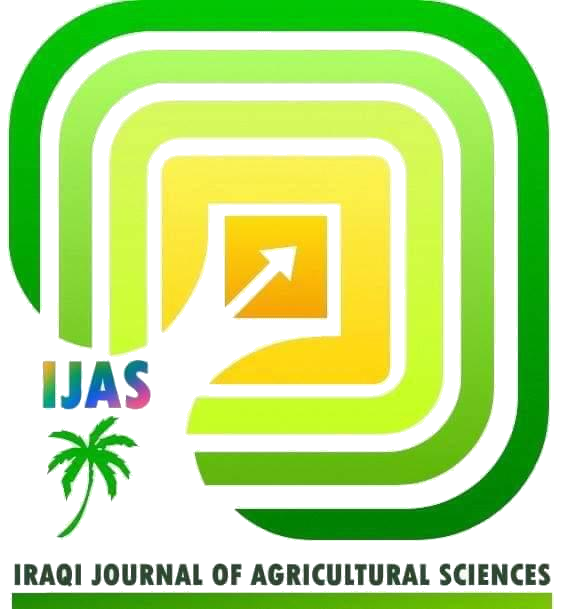IMPROVING THE QUALITY OF GLUTEN-FREE BREAD MANUFACTURED FROM PROSO MILLET USING HYDROCOLLOIDS
DOI:
https://doi.org/10.36103/gm5w7t56Keywords:
xanthan gum, glycerol, sensory properties, soaking, proso millet.Abstract
The aim of this study was to investigate the role of some hydrocolloids in improving the physical and sensory properties of gluten-free bread manufactured from millet flour. Whole grain millet flour (T2), whole grain millet flour with xanthan gum (T3), whole grain millet flour with guar gum (T4), unprocessed millet flour with extraction rate of (71%) with xanthan gum (T5), unprocessed millet flour with extraction rate of (71%) with guar gum (T6) ,were used to prepare gluten free bread beside another treatment manufactured by the same ingredients with replacing the sugar by glycerol (T7).The wheat flour was used as standard (T1). The results of the chemical composition showed that whole-grain Proso millet flour had higher percentages of fat, protein, ash and fiber, and lower moisture and carbohydrates content, in comparison to wheat flour. The amylose content were (38.46 - 26.25%) for wheat flour and whole grain millet flour respectively, which indicates that Proso millet is a non-waxy cultivar. The results of the physical properties of the baking product, represented by volume and specific volume, showed that T1 and T3 outperformed over the rest treatments. A sensory evaluation indicated that gluten-containing bread was more acceptable to consumers. Followed by gluten-free bread with xanthan gum, as the total scores for these two treatment were (94.73 , 85.92 ). While for T2, T3, T4, T6, T7 treatments were (44.44, 77.62, 54.72, 62.39, 82.45).
References
1. Adedeji, A. A., M. Singh; F. Akharume; and J. Woomer. 2018. Proso millet application in the development of gluten free products. In 3rd International Millet Symposium.
2. Al.jobory, S.H.A. 2011. Effect of Addition barley flour on rheological properties of wheat flour. Tikrit University Journal of Science. Volume 11; Issue 3.
3. AL-Abas, M. M., and J. M. Nasser, 2025. Optimal conditions for extraction phenolic compounds and flavonoids from millet bran and studying some of their biological activity. Iraqi journal of agricultural sciences, 56(special), 57-67. https://doi.org/10.36103/d7vwy494
4. Al-Mhyawi, E. K., and J. M. Nasser. 2023. Physical and functional properties of some millet cultivars in Iraq. In IOP Conference Series: Earth and Environmental Science, V. 1225, No.(1): pp: 3-8. IOP Publishing. doi 10.1088/1755-1315/1225/1/012036
5. Alvarenga, N. B., F. Cebolalidon; E.Belga; P.Motrena;S. GuerreiroandM. J. Carvalho. 2011. Characterization of gluten-free bread prepared from maize, rice and tapioca flours using the hydrocolloid seaweed agar-agar. Recent Research in Science and Technology, 3, 64-68.
6. Amadou, I.; M. E.GoungaandG. W. Le. 2013. Millet s: Nutritional composition, some health benefits and processing-A review. Emirates Journal of Food and Agriculture, 501-508.
7. Cammenga , H. K. ; B. Figura and B. Zielasko. 1996. Thermal behavior of some sugar alcohol . J. Thermal Analysis. 47:427-434.
8. Dayakar Rao, B.; K. Bhaskarachary; G. D. Arlene Christina; D.G. Sudha;A. T. Vilas andTonapi, A. 2017. Nutritional and health benefits of millets. ICAR_Indian Institute of Millet s Research (IIMR): Hyderabad, Indian, 112-115.
9. Emmanuel, K. and A. Sackle. 2013. Nutritional and sensory analysis of millet based sponge cake. International Journal of Nutrition and Food Science, 2(6), 287-293.
10. Gulati, P.; Y. Zhou; C. Elowsky and D. J. Rose . 2018. Micro structural changes to proso millet protein bodies upon cooking and digestion. Journal of Cereal Science, 80, 80-86.
11. Hammood, E. K., M. N. Khalaf and J. M. Naser. 2024. Effect of Adding Malva neglecta L. Leaves Powder on the Sensory Properties of Laboratory Biscuits. In IOP Conference Series: Earth and Environmental Science. V.1371, No.6, pp. 4-13. IOP Publishing. doi.10.1088/1755-1315/1371/6/062031
12. Hammoud, E. K., A. C. Saddam and J.M. Nasser 2024. Improving nutritional and qualitative properties of wheat bread by using mallow (Malva neglecta L.) Leaves powder. Iraqi Journal of Agricultural Sciences, 55(1), 560-568. https://doi.org/10.36103/8p73pr77
13. Hymavathi, T. V.;T. P. Roberts; E. JyothsnaandV.T. Sri. 2020. Proximate and mineral content of ready to use minor millet s. IJCS, 8(2), 2120-2123.
14. Karkannavar, S. J.;S. Shigihalli;G. Nayak and P. Bharati. 2021. Physico-chemical and nutritional composition of proso millet varieties. IJCS, 10(3), 138-139.
15. Kazim, E.; J. M. Nasser and E. A. Saleh. 2012. The effect of adding Nigella sativa to some baked products. University of Karbala, Second Scientific Conference of the College of Agriculture. 1117-1118.
16. Kulkarni D.B.; B. K.Sakhaleand N. A. Giri. 2018. A Potential review on millet grain processing. Int J Nutr Sci 3(1): id1018. www.austinpublishinggroup.com.
17. Mahdi, N. S., and K. A. Shakir 2025. Impact of green parts powder of locally cultivated carrot (Daucus carota L.) on qualitative and sensory properties of biscuits and cake. Iraqi Journal of Agricultural Sciences, 56(special), 20-32. https://doi.org/10.36103/7st3sd12
18. Matos Segura, M. E. andC.M. Rosell. 2011. Chemical composition and starch digestibility of different gluten-free breads. Plant Foods for Human Nutrition, 66(3), 224-230.
19. Mohankumar, J. B. andI. Vaishnavi. 2012. Nutrient and antioxidant analysis of raw and processed minor millet s. Elixir Food Science. A, 52, 11279-11282.
20. Nasser, J.M. ; Saleh, E.A. and E. K. Hammood. 2016. Making cake from Iraqi rice. Journal of Biological Chemistry and Environmental Sciences. V.11(3). 305-313.
21. Reddy, M. C. and S. Aneesha. 2019. Physico-Chemical properties of different millet s and relationship with cooking quality of millet s. International Journal of Multi-disciplinary Research and Development. Online ISSN: 2349-4182, Print ISSN: 2349-5979; Impact Factor: RJIF 5.72. Volume 6; Issue 4; April; Page No. 97-101.www.allsubjectjournal.com
22. Schober, T. J.; M. Messerschmitt; and S. R. Bean; S. H. Park and E. K. Arendt. 2005. Gluten‐free bread from sorghum: quality differences among hybrids.Cereal Chemistry, 82(4), 394-404.
23. Singh, K. P. and H. N. Mishra. 2014. Millet -wheat composite flours suitable for bread. Journal of Ready to Eat Food, 49-58.
24. Šmídová, Z.and J. Rysová. 2022. Gluten-free bread and bakery products technology. Foods, 11(3), 480.
25. Wang, H., Y. Fu, Q. Zhao, D. Hou, X. Diao, Y. Xue. and Q. Shen. 2022. Effect of Different Processing Methods on the Millet Polyphenols and Its Anti-diabetic Potential. Frontiers in Nutrition. Pp: 101. doi: 10.3389/fnut.2022.780499
26. Whaib, E. S. and A. M. Mousa. 2022. The impact of ozone gas treatment on the amylose/amylopectin ratio in Iraqi jasmine rice grains. Eurasian Chem. Commun. 4 , 870-876.http:/echemcom.
Downloads
Published
Issue
Section
License
Copyright (c) 2025 IRAQI JOURNAL OF AGRICULTURAL SCIENCES

This work is licensed under a Creative Commons Attribution-NonCommercial 4.0 International License.

2.jpg)


